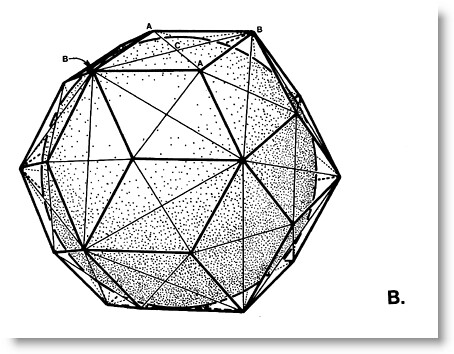The Platonics have been played with for ages. They're a closed set under the operation of "dualing" i.e. the dual of a Platonic, is a Platonic, the tetrahedron being self dual.
Dual(Tetrahedron) is Tetrahedron
Dual(Octahedron) is Cube
Dual(Icosahedron) is Pentagonal Dodecahedron
The self-dual tetrahedron gives rise to the cube and there, with mutual orthogonality, we get phi entering the picture, as mutually orthogonal rectangles supporting the icosahedron of twenty equilateral surface triangles.
The Borromean Rings may or may not enter the picture at this juncture.
The icosahedron, crossed with it's own dual, yields the rhombic triancontahedron (RT). Hold that thought. It has thirty "wedges" to the center, thirty diamond faces.
Turning next to the TetraBook, you'll remember how DB Koski was tilting its page. That's not the only possible TetraBook by the way. A 2x2 square, three of those corner-intersecting, makes our octahedron, half of which could be a book.
Again, with an isosceles page straight up (angles 45, 45, 90), you have unit volume (1/4 of the octahedron's total). That's unit in IVM tetravolumes (vs XYZ cubic volumes).
The classic TetraBook has equilateral 2x2 triangular book covers, with one page flapping back and forth, same size. Click stopping at volume stops map(√, (9/8, 8/8, 7/8, 6/8, 5/8, 4/8, 3/8, 2/8, 1/8, 0)) may seem a bit quirky, but at √(4/8) volume, he notes a volume of 4 E3, the same as a wedge in the aforementioned RT.
E3 = √2/8 and 4 * E3 = √(4/8), one of the volume click stops along the TetraBook track.
The notation is such that the RT hugging (shrink-wrapping) a unit-radius sphere is made of E-modules, which scaled up by phi are E3 modules, as volume is upped by phi to the 3rd power when the thing is linearly scaled by that amount.
Scaling down by phi is lowercase: e3. We have self-similar E6, e6 etc., going up and down the size spectrum.
Reducing volumes to canonical assorted "sizes of E-module" is one of DB Koski's focal points. He'll do the equivalent with S modules given their simple volumetric relationship: VE:icosa :: S:E (S:E is the so-called "S factor").
The TetraBook track is important for the last two stops, 8/8 and 9/8. Those are the two unit volumes in the IVM and XYZ coordinate systems.
Dual(Tetrahedron) is Tetrahedron
Dual(Octahedron) is Cube
Dual(Icosahedron) is Pentagonal Dodecahedron
The self-dual tetrahedron gives rise to the cube and there, with mutual orthogonality, we get phi entering the picture, as mutually orthogonal rectangles supporting the icosahedron of twenty equilateral surface triangles.
The Borromean Rings may or may not enter the picture at this juncture.
The icosahedron, crossed with it's own dual, yields the rhombic triancontahedron (RT). Hold that thought. It has thirty "wedges" to the center, thirty diamond faces.
Turning next to the TetraBook, you'll remember how DB Koski was tilting its page. That's not the only possible TetraBook by the way. A 2x2 square, three of those corner-intersecting, makes our octahedron, half of which could be a book.
Again, with an isosceles page straight up (angles 45, 45, 90), you have unit volume (1/4 of the octahedron's total). That's unit in IVM tetravolumes (vs XYZ cubic volumes).
The classic TetraBook has equilateral 2x2 triangular book covers, with one page flapping back and forth, same size. Click stopping at volume stops map(√, (9/8, 8/8, 7/8, 6/8, 5/8, 4/8, 3/8, 2/8, 1/8, 0)) may seem a bit quirky, but at √(4/8) volume, he notes a volume of 4 E3, the same as a wedge in the aforementioned RT.
E3 = √2/8 and 4 * E3 = √(4/8), one of the volume click stops along the TetraBook track.
The notation is such that the RT hugging (shrink-wrapping) a unit-radius sphere is made of E-modules, which scaled up by phi are E3 modules, as volume is upped by phi to the 3rd power when the thing is linearly scaled by that amount.
Scaling down by phi is lowercase: e3. We have self-similar E6, e6 etc., going up and down the size spectrum.
Reducing volumes to canonical assorted "sizes of E-module" is one of DB Koski's focal points. He'll do the equivalent with S modules given their simple volumetric relationship: VE:icosa :: S:E (S:E is the so-called "S factor").
The TetraBook track is important for the last two stops, 8/8 and 9/8. Those are the two unit volumes in the IVM and XYZ coordinate systems.


